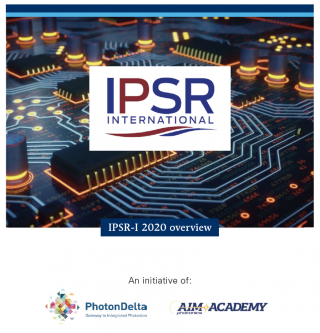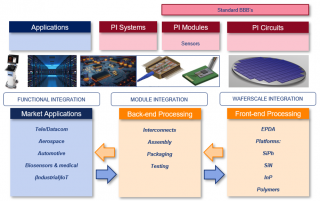Roadmap Structure & Overview
Download the IPSR-I 2020 Overview
 A collaborative effort between MIT's Microphotonics Center and the Netherlands-based PhotonDelta. The IPSR-I is the result of the efforts of about 400 academic and industrial scientists from all over the world, working in the field of integrated photonic technologies and their applications. It gives an overview of the current status of technologies and of applications in which integrated photonic components are used. The IPSR-I is a living document that is continuously updated. A continuous call is open for contributions by experts in the various technological and applicational fields to contribute to updating the IPSR-I.
A collaborative effort between MIT's Microphotonics Center and the Netherlands-based PhotonDelta. The IPSR-I is the result of the efforts of about 400 academic and industrial scientists from all over the world, working in the field of integrated photonic technologies and their applications. It gives an overview of the current status of technologies and of applications in which integrated photonic components are used. The IPSR-I is a living document that is continuously updated. A continuous call is open for contributions by experts in the various technological and applicational fields to contribute to updating the IPSR-I.
Above all it describes the trends, expectations and needs for technology and application development in the near (0-5 years), intermediate (5-10 years) and far (10-20 years) future. The roadmap shows the functional performance requirements of the applications (shown below in blue) and the technologies with which these can be created (orange). The modules and systems are the interface between the application manufacturers and Integrated Circuit industry; it at this interface the functional performance parameters are converted to component requirements and vice versa.

IPSR-I 2020 creates synergy by relying on both institutions to coordinate technological vision, development, and implementation of effective manufacturing strategies for emerging technologies. IPSR-I integrates and expands upon the sucessful roadmapping efforts of both partners to address systems and manufacturing needs in integrated photonics.
Developed by seventeen working groups, each focused on a particular field, module or technology, the IPSR-I 2020 Roadmap highlights the performance requirements necessary for these applications and the ecosystems in which they can be created. Modules and systems are the interface between the application manufacturers and the integrated circuit industry. It's at this interface the functional performance parameters are converted to component requirements and vice versa.
The high performance, low cost and small formfactor of integrated photonic modules is a core part of the infrastructure for solving the large societal challenges. The IPSR-I prescribes the technological gaps that industry and academia need to bridge to deliver these solutions to society. Solving these gaps contributes directly to five Sustainable Development Goals:

820 million people don’t have enough to eat, and 9 million people die of starvation annually. Integrated photonic modules provide affordable and accessible climate data from satellites and other sensors. This data increases crop yields whilst reducing the use of water, land and pesticides. Measuring the shape, color, sugar content, and other parameters of our food throughout the whole supply chain (from farm to fork) with small, low cost PIC modules greatly reduces food waste.

Medical imaging is greatly improved by PICs due to their high data-rates, allowing for real-time scanning of the full body. The small footprint makes them suitable in-body use or handheld devices. And the low cost of these chips makes them also accessible for poorer and remote communities. These developments contribute to a better health by better diagnosis and gives researchers the tools for development of vaccines and cures. Pollutants can be tracked by wearables so they can be avoided.

A basic need for industry is the availability of reliable fast internet infrastructure with low latency.5/6G and satellite communication modules use integrated photonics to improve performance and increase accessibility for all communities. Science is boosted by the availability of better equipment using PIC technology. Manufacturing equipment and processes can be greatly boosted in performance, flexibility reliability and yield by generating data about the process for timely adjustment by using PIC sensors.

The citizens of the world become increasingly urbanized, transport is causing a range of issues for health and environment due to heavy pollution. One of the solutions for higher safety, affordability and accessibility is autonomous transport that reduces pollution and increases efficiency. Integrated photonic modules will enable the infrastructure to handle the required data, positioning and timing. Small, affordable, high reliability sensors improve the awareness of the vehicles to reduce accidents.

Currently datacenters consume about 3% of the global energy production, it is predicted that the growing adoption of the internet and increased demand for higher bandwidths will increase this number to 10% in 2030 if nothing changes. Integrated photonics can reduce the energy loss in datacenters by 80% by developing improved transceivers, which allow for smarter architectures and less air-conditioning use. This results in a net reduction of the CO2 emissions by datacenters of 1% compared to 2020, whilst handling much more data.
